When it’s a South Vancouver or Point Grey by-law!
By-laws, as you likely know, are the mechanism by which municipal councils are able to exert their statutory authority. They are therefore important legally, but also for providing current and historical context as to why a municipality runs the way it does. As such, the City by-law series of the City of Vancouver fonds (Series 36) is a fairly heavily used records group at the Archives. Researchers are able to search for the description of each by-law through the Archives’ database, which includes the by-law number, its title and date.
The City of Vancouver by-laws, however, are not the only municipal by-laws the Archives holds. The Archives also holds the by-laws from the former municipalities of South Vancouver and Point Grey.
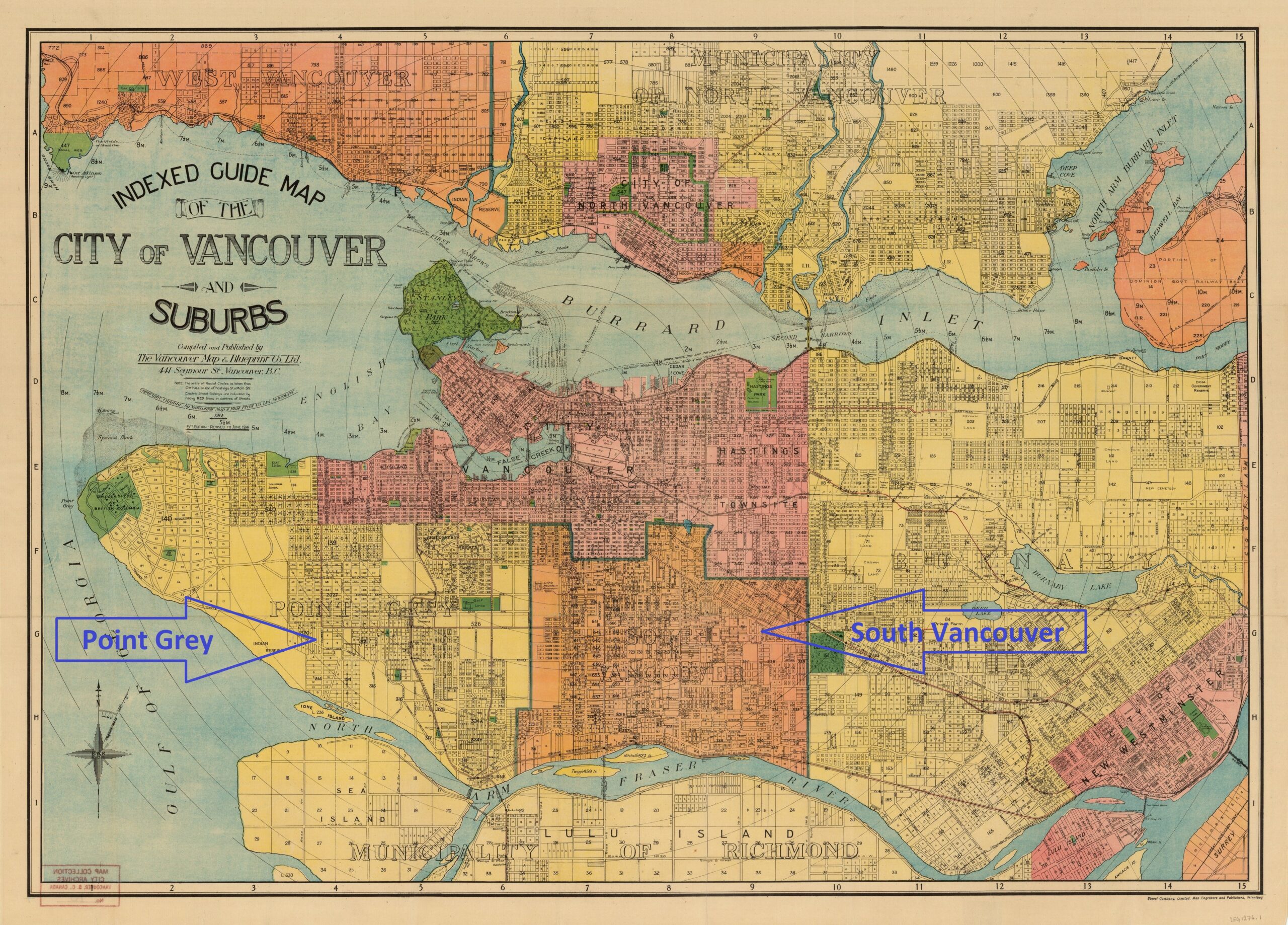
The Municipality of South Vancouver formed in 1892, six years after the City of Vancouver was incorporated. It was bounded more-or-less by the City of Vancouver to its north, Burnaby to the west, and the Fraser River to the south. Its boundaries did not remain geographically large for long, for in 1908, the residents of the west side of the municipality formed a separate municipality, that of Point Grey. This municipality was even shorter lived, as on January 1, 1929, South Vancouver, Point Grey, and the City of Vancouver, amalgamated, creating the city boundaries we know today.
Until recently, the by-laws of both South Vancouver and Point Grey were rather less-well described than those of the City of Vancouver in the Archives’ database. To make them more discoverable, we rehoused each by-law into individual folders, and modified our descriptions from the very broad file level descriptions of, for example, ‘By-laws 1-100’, to include the number and name of each by-law, in keeping with the way the City of Vancouver by-laws have been housed and described.
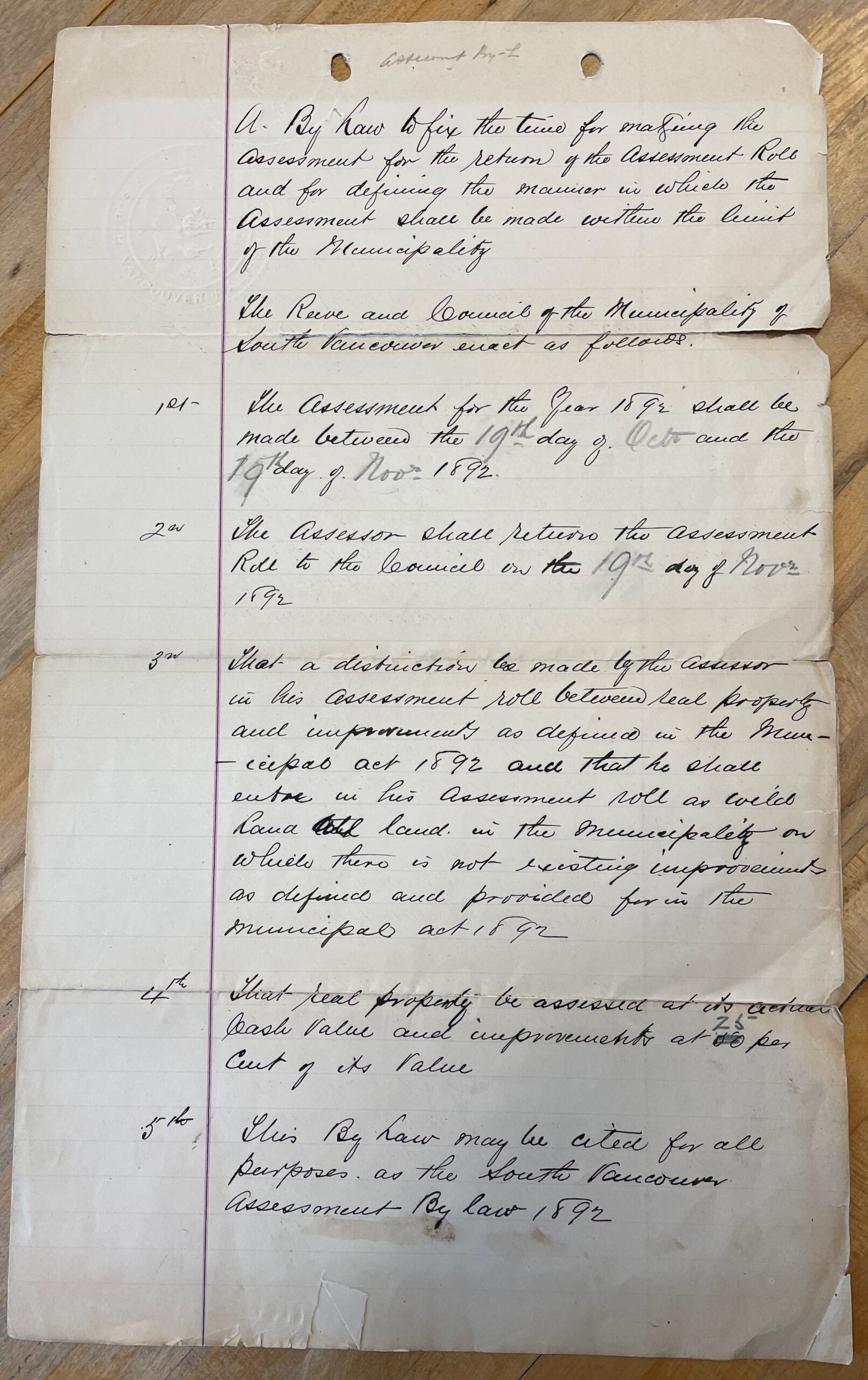
It can be interesting to look at the by-laws, as they provide insight into a variety of the dimensions of the municipality that passed them, including recordkeeping methods, technological changes, urban development, and the finances of the municipalities.
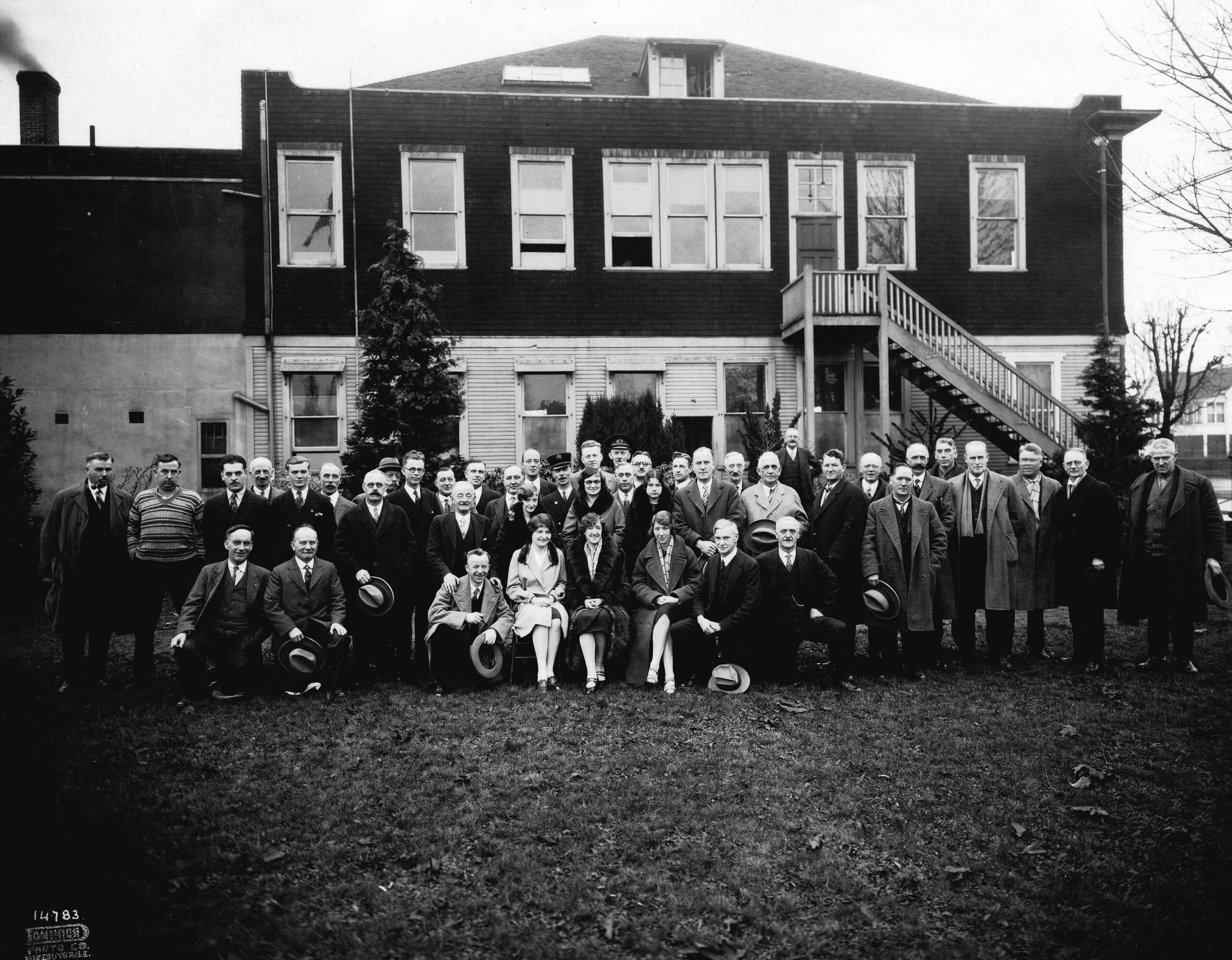
When it comes to recordkeeping methods, the Municipality of South Vancouver is well-known at the Archives for their somewhat chaotic (at least from our perspective) approach. The by-laws are no exception. There are by-laws which are completely missing. There are by-laws where the signed and sealed original (the official version) is missing but a typed or hand-written version still exists. And there are the official, signed and sealed by-laws. The by-law numbering system employed over the municipality’s history was probably logical to the South Vancouver administration, but seems rather scattered, especially when compared to the numbering system of Point Grey or the City of Vancouver. One of the accompanying indexes to the South Vancouver by-laws lists the by-laws in order, but this numbering system certainly appears to have been imposed much later in the municipality’s history. The index also notes that some by-laws are ‘missing’, or ‘cancelled’, or ‘duplicates’, or ‘These numbers have not been used’.
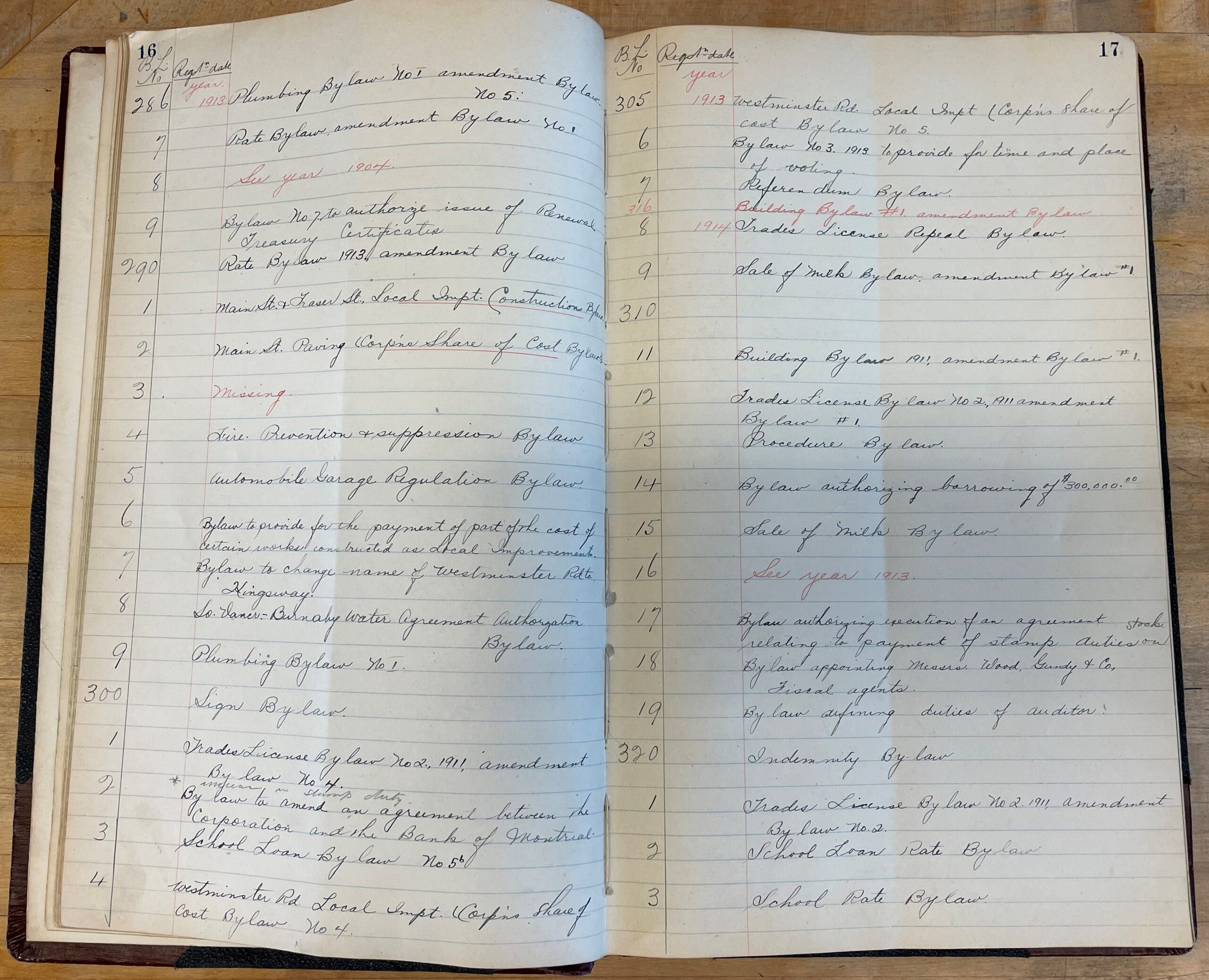
The recordkeeping methods of Point Grey, on the other hand, are much clearer, and are indeed prescribed in the very first by-law passed by the municipality: ‘All By-laws shall be numbered each year consecutively as they are passed commencing from the number one, and shall be known and designated by the numbers respectively endorsed upon them, with the year in which they were passed.’ For example, this would mean that the first Point Grey by-law would be numbered ‘By-law no. 1, 1908.’ However, as logical as their numbering system was, it wasn’t quite as straightforward as the City of Vancouver’s numbering system, which just gave and still gives each by-law a unique, sequential number, starting with By-law no. 1.
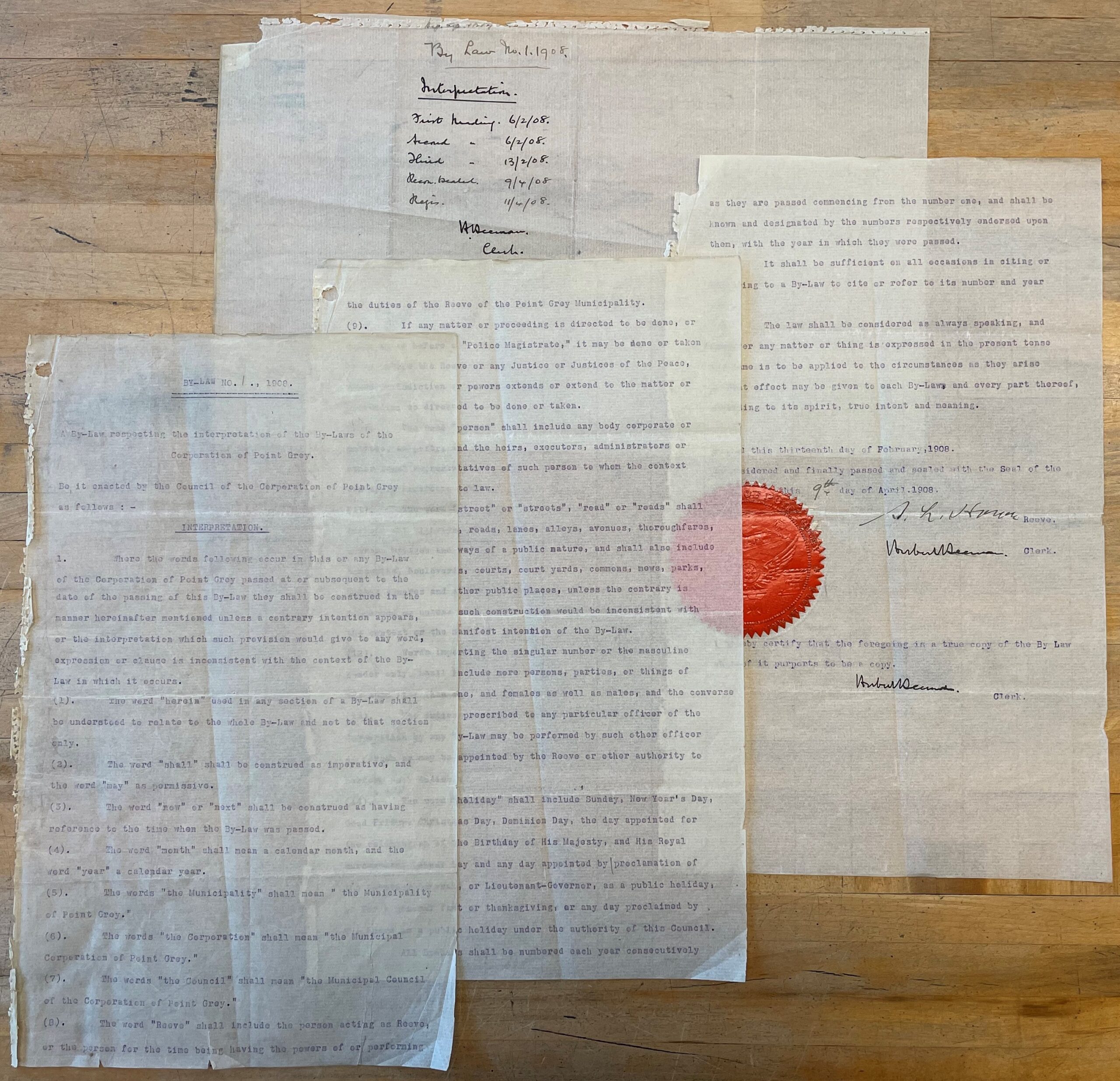
So what were the first by-laws passed by each municipality? South Vancouver started with ‘Highway By-law no. 1’ in 1892, at least according to the index of by-laws, but unfortunately this is one of the missing by-laws. Its second, and only other by-law passed that year was the ‘Assessment by-law no. 2 : a by-law to fix the time for making the assessment for the return of the assessment roll’. Point Grey, on the other hand, started with its first three by-laws to establish its government functions, including By-law no. 1 : a by-law respecting the interpretation of the by-laws of the Corporation of Point Grey (the one describing how the by-law number system was to work), By-law no. 2 : for regulating the proceedings of the council, and for defining the duties of the officers of the Corporation of Point Grey, and Bill no. 3 : a by-law to adopt a common seal for the Corporation of Point Grey, all passed in 1908. The City of Vancouver also prioritised government administration structure with its By-law no. 1 : a by-law to appoint certain officers for the City of Vancouver when it became a city in 1886.
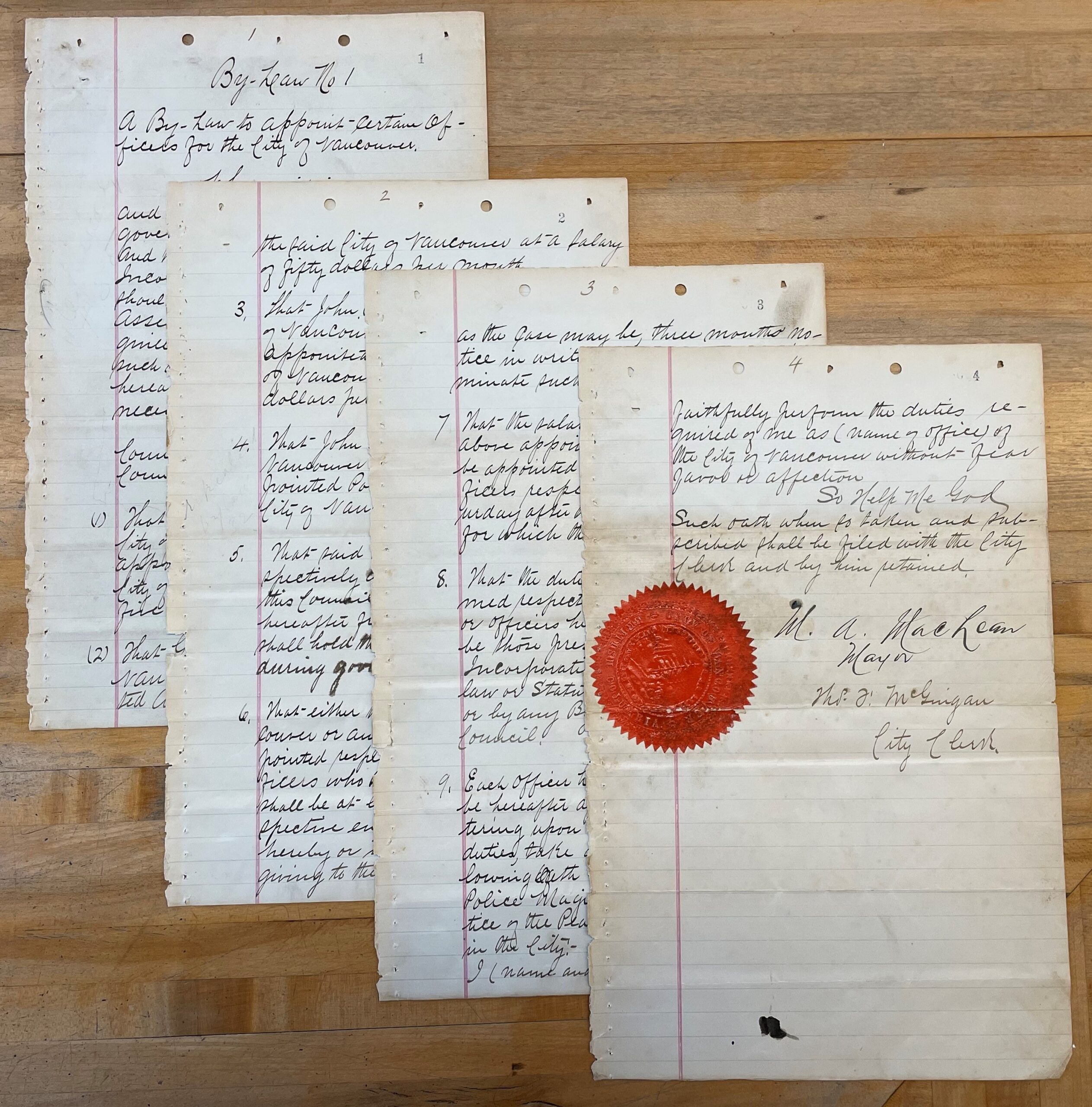
Fast forwarding a bit, South Vancouver, Point Grey, and the City of Vancouver all passed by-laws in December 1926 that provided for taking a plebiscite on the question of amalgamation. All had slightly different titles, and of course different by-law numbers, but with the result that votes were taken by their respective citizens, and that on January 1, 1929, the three became the City of Vancouver. Just before South Vancouver gave up its status as a separate municipality, it passed By-law no. 1996 : a by-law for establishing certain public parks and recreation grounds on December 27, 1928. Point Grey passed its last by-law By-law no. 954 : a by-law to provide for the application of sinking fund surplus on December 31, 1928. And the City of Vancouver passed By-law no. 1951 on December 17, 1928, which was a zoning by-law. On the second of January, 1929, the Council of the newly expanded City of Vancouver passed By-law no. 1957, repealing particular South Vancouver and Point Grey by-laws.
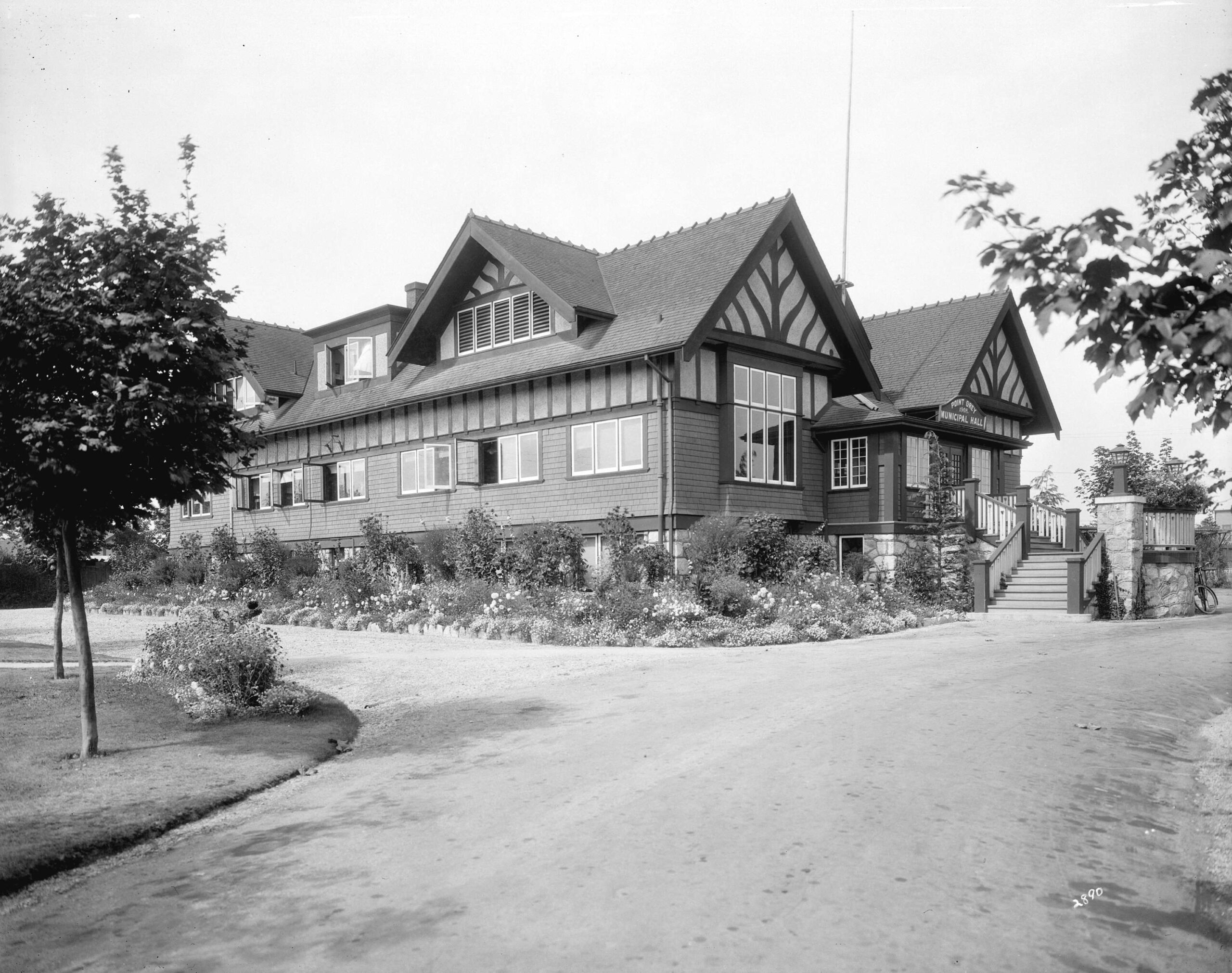
What were some of the more interesting by-laws that the two municipalities passed before amalgamation? South Vancouver’s bakeshops by-law from 1916 is worth a read. It details the essential ingredients of loaves of bread (‘made of flour or meal of the cereals of wheat or rye’) and the minimum size (no less than 10 oz. in weight). After defining the key attributes of a loaf of bread, the remaining three-quarters of the by-law outlines the cleanliness with which bakeshop establishments and their delivery vehicles were to be kept. This by-law also gives a window into a by-gone era, stating that ‘No Bakeshop shall be situate within Twenty feet (20 ft.) of any stable’, ‘All bread shall be delivered from baskets’, and ‘nor shall any person smoke, use snuff or chew tobacco in any working room, whilst work is in progress.’
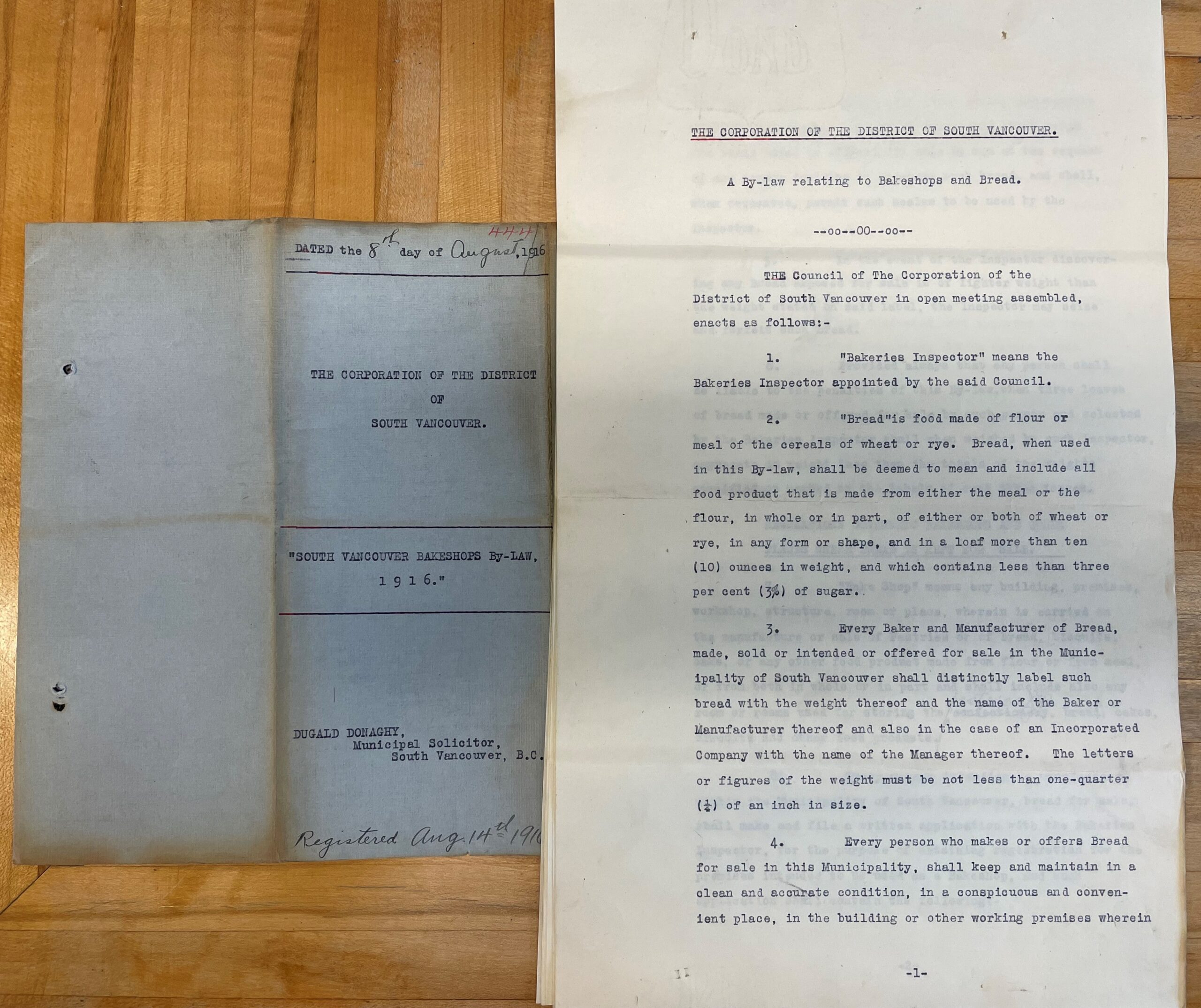
Point Grey passed a noxious weeds by-law in August 1908. If you are counting, it was the thirteenth by-law the municipality ever passed. It wasn’t the first noxious weeds by-law, however, as the City of Vancouver passed a similar one in 1894 (By-law no. 209). The Point Grey By-law specifies that ‘Every owner, lessee, tenant or occupant of any land and the agent for the same, on which there is growing Canadian, Scotch or bull thistles, burdocks, wild mustard, or any other noxious weed, shall cut and destroy all such weeds before they shall have begun to flower.’ Failure to do so could result in ‘a penalty not exceeding the sum of $100 and costs, for each offence.’
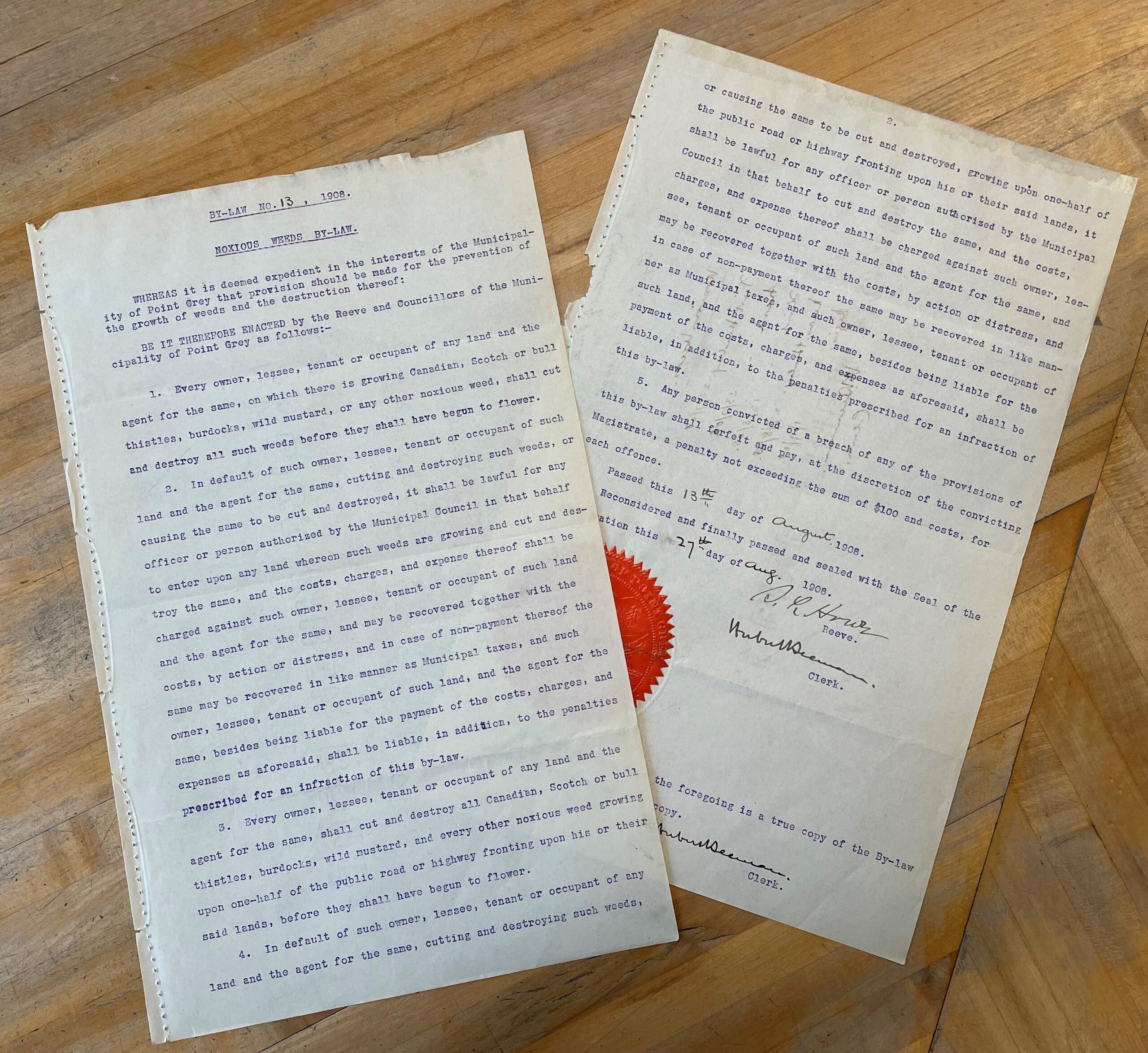
So don’t let by-laws be by-laws. If delving into early municipal by-laws tickles your fancy, have fun searching our database, and pop by the Reading Room to view them.


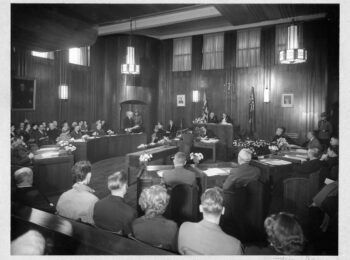
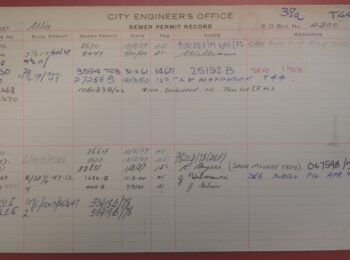
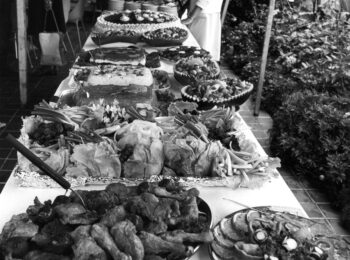
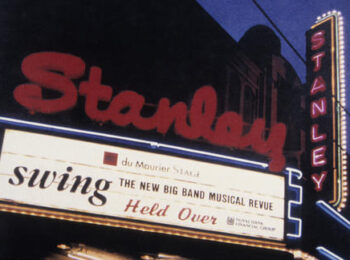
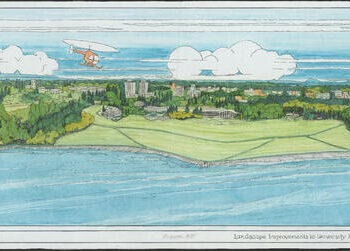
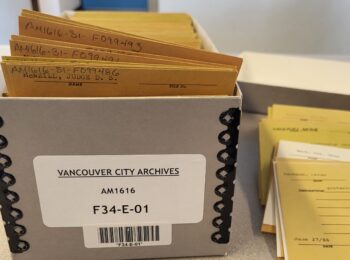
Noticing that there was a still a “Bread By-law” of some kind in 1966 in Vancouver. I wonder what that was?
Various bread-related by-laws were in place in Vancouver up until 1979, when By-law no. 5287 : a by-law to repeal by-law no. 4388 being the Bread By-law, was passed. The by-laws generally define what is considered ‘bread’, the role of an bread/bake shop inspector, the required minimum weight a loaf, the wrapper specifications, prohibited ingredients, and fines incurred for breaking the by-laws. They can make for some interesting reading.
Here is a link to our database descriptions of the various bread-related by-laws, available for viewing in our reading room:
https://searcharchives.vancouver.ca/informationobject/browse?sq0=s36&sf0=&so1=and&sq1=bread*&sf1=&levels=&onlyMedia=&findingAidStatus=©rightStatus=&materialType=&topLod=0&startDate=&endDate=&rangeType=inclusive